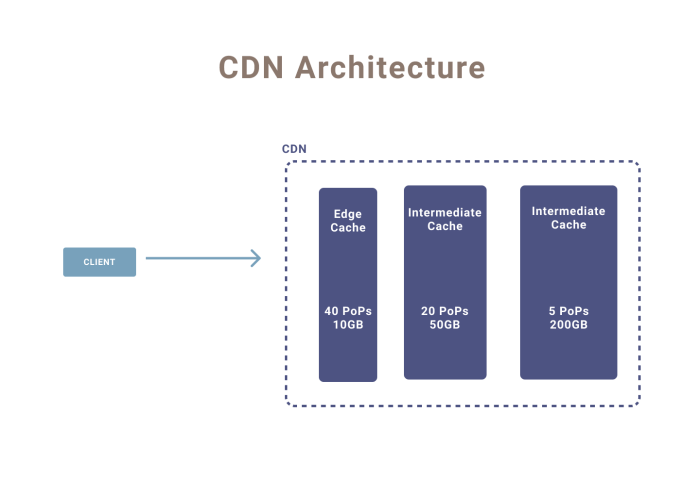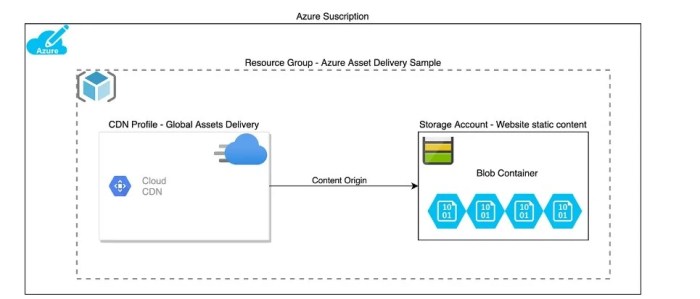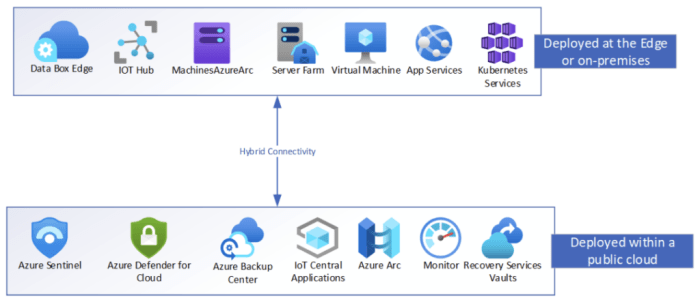Unlocking the potential of your application’s performance is crucial in today’s fast-paced digital world. Content Delivery Networks (CDNs) offer a powerful solution to accelerate delivery and enhance user experience. This comprehensive guide dives deep into the intricacies of leveraging CDNs to boost application performance, from initial setup to ongoing optimization and security considerations.
This guide will walk you through choosing the right CDN provider, integrating it seamlessly into your application architecture, and optimizing both static and dynamic content for optimal delivery. We’ll also examine key performance indicators, security best practices, and tailored strategies for diverse application types, including mobile apps and e-commerce platforms.
Introduction to Content Delivery Networks (CDNs)

A Content Delivery Network (CDN) is a geographically distributed network of servers that store cached copies of website content. These servers are strategically positioned across various locations worldwide, allowing for quicker delivery of content to users regardless of their physical location. This global distribution is crucial for improving website performance and user experience.The primary purpose of a CDN is to reduce latency, improve website load times, and enhance overall user experience.
By caching static content closer to users, CDNs effectively minimize the distance data needs to travel, leading to faster delivery and a more responsive website.
Fundamental Benefits of Using a CDN
CDNs offer significant advantages for application performance. They serve as a crucial component in optimizing web experiences. These advantages include:
- Reduced Latency: CDNs strategically place servers globally, minimizing the distance data needs to travel to reach users. This translates to faster loading times and a more responsive application for users across the world.
- Improved Performance: By caching frequently accessed content, CDNs drastically reduce server load and response times. This improvement is particularly noticeable for applications with a large user base or geographically diverse users.
- Enhanced Reliability: Distributed servers in a CDN provide redundancy and fault tolerance. If one server fails, other servers can seamlessly take over, ensuring uninterrupted service and preventing downtime.
- Increased Scalability: CDNs can easily scale to meet fluctuating demands. During peak traffic periods, the network automatically distributes the load across multiple servers, preventing performance bottlenecks and ensuring a smooth experience for all users.
Caching Concepts in CDNs
Caching is the core mechanism enabling CDNs to deliver content quickly. It involves storing frequently accessed content in intermediary locations closer to users. This approach reduces the need for direct access to origin servers, which are typically located in a central location. This method speeds up the delivery of requested content.
- Origin Server: The original source of content, often a web server hosting the website or application. Content is typically generated or stored on the origin server.
- CDN Edge Servers: These are strategically placed servers across the globe. They store cached copies of content from the origin server.
- User Request: When a user requests content from a website, the CDN edge server closest to the user responds.
- Caching Logic: If the content is cached, the edge server delivers it directly to the user. If not, the edge server retrieves the content from the origin server and caches a copy for future requests.
Illustrative Analogy
Imagine a library with branches in multiple cities. The main library (origin server) holds all the books. Each branch (CDN edge server) has copies of frequently borrowed books. When a person in a city needs a book, they go to the nearest branch (edge server). If the book is there, they get it quickly.
If not, the branch requests the book from the main library (origin server), receives it, and places a copy in the branch for future use. This ensures books are available to everyone efficiently.
CDN Selection and Implementation
Selecting the right CDN and seamlessly integrating it into an application architecture is crucial for maximizing performance gains. A poorly chosen or improperly integrated CDN can negate the benefits of using a CDN, potentially even hindering performance. Careful consideration of various factors and providers is essential for achieving optimal results. This section delves into the process of selecting a suitable CDN and integrating it into existing application structures.Careful evaluation of the different CDN providers and their features is vital for achieving optimal performance and cost-effectiveness.
The selection process involves assessing various factors, including geographic coverage, pricing models, supported technologies, and technical support. A thorough comparison of different CDN providers is essential for informed decision-making.
CDN Provider Comparison
Different CDN providers cater to various needs and budgets. Comparing providers involves analyzing their features, pricing structures, and geographic coverage. Key features to consider include edge server locations, content caching capabilities, and security protocols. Analyzing the pricing models is also crucial to ensure the chosen provider aligns with the budget.
| Provider | Features | Pricing | Geographic Coverage |
|---|---|---|---|
| CloudFlare | Robust caching, DDoS protection, and extensive global network | Tiered pricing based on features and usage | Worldwide coverage with high density in major regions |
| Akamai | High-performance delivery, enterprise-grade security, and comprehensive analytics | Typically a higher-cost option with flexible packages | Global reach with strong presence in key markets |
| Fastly | Low latency, high-availability solutions, and advanced edge computing | Flexible pricing models, often based on bandwidth and features | Wide global coverage, with a focus on performance in specific regions |
Choosing a Suitable CDN
The selection process for a suitable CDN should align with specific application needs. Consider factors like expected traffic volume, content types, and geographic distribution of users. A CDN with adequate capacity to handle anticipated traffic spikes is essential.
- Application Traffic Patterns: Understanding the typical traffic patterns of the application is crucial. Peak traffic times, user demographics, and expected growth will influence the CDN’s capacity requirements.
- Content Characteristics: The nature of the content being delivered impacts the selection process. Static content like images and videos benefit greatly from CDN caching, while dynamic content may require specialized integration strategies.
- Budget Constraints: CDN pricing models vary. It is important to compare pricing structures and select a provider that fits within the allocated budget.
CDN Integration Process
Integrating a CDN into an existing application architecture involves several steps. The specific methods will vary depending on the application’s structure and the chosen CDN provider. A well-defined integration plan is essential for a smooth transition.
- Configuration: Configure the CDN to correctly identify and cache the required content. This involves setting up appropriate origin server connections and configuring caching rules.
- Content Delivery: The CDN’s edge servers now serve the content directly to users based on their location. This minimizes latency and enhances performance.
- Monitoring and Optimization: Continuous monitoring and analysis of CDN performance are essential for identifying and addressing potential bottlenecks or issues. Adjusting caching strategies and optimizing delivery mechanisms are crucial for maintaining optimal performance.
Integration Methods and Best Practices
Various integration methods exist, each with its own set of advantages and disadvantages. The best method depends on the specific application architecture and the desired level of customization.
- Content Delivery Network API: Many CDNs provide APIs that allow developers to manage and control content delivery through programmatic interfaces. This often provides more granular control over caching and routing.
- Origin Server Configuration: Some CDNs require modifications to the origin server configuration to direct traffic to the CDN. This typically involves configuring the origin server to respond to requests from the CDN’s edge servers.
- Custom Integrations: In certain cases, developers may need to build custom integrations to handle specific requirements. This requires in-depth knowledge of both the application and the CDN’s functionalities.
Optimizing Application Performance with a CDN
Leveraging a Content Delivery Network (CDN) significantly enhances application performance by distributing content closer to users. This proximity reduces latency, improving the overall user experience. A well-configured CDN acts as a crucial component in ensuring fast loading times and a seamless user journey.CDN caching mechanisms strategically store content at geographically dispersed servers. This intelligent placement allows users to access content from a server located closer to their physical location, minimizing the distance data must travel, thus mitigating latency.
This fundamental principle underlies the significant performance improvements CDNs offer.
CDN Caching Mechanisms and Latency Reduction
CDN caching mechanisms store frequently accessed content at edge servers strategically positioned globally. This proximity significantly reduces the distance data needs to travel, resulting in substantially lower latency. When a user requests content, the CDN can quickly serve it from a nearby edge server, minimizing the delay experienced by the user. This caching strategy ensures that users receive content rapidly, enhancing application responsiveness.
Optimizing Static Assets for CDN Delivery
Static assets, such as images, CSS files, and JavaScript libraries, are ideal candidates for CDN optimization. These files, often unchanged, are frequently requested by users. By placing these assets on a CDN, you can reduce the load on your origin server, thereby improving its efficiency and responsiveness.
- Efficient Delivery of Static Content: By storing static assets on a CDN, the delivery of frequently accessed files is expedited, decreasing the latency associated with loading them. This is achieved by serving the assets from the nearest edge server.
- Reduced Origin Server Load: When static assets are served from a CDN, the origin server experiences less load, enabling it to handle more dynamic requests and reducing the risk of server overload.
- Improved Website Performance: Consequently, the website’s overall performance improves due to faster loading times for static content, providing a smoother and more responsive user experience.
Optimizing Dynamic Content Delivery via a CDN
Dynamic content, generated based on user requests or database queries, requires a different approach for optimal CDN delivery. Simply placing dynamic content on the CDN might not be the most effective strategy.
- Caching Strategies for Dynamic Content: Implementing appropriate caching strategies for dynamic content is critical. Strategies such as conditional caching, or using a CDN’s caching headers, can control the caching period and ensure that only the latest versions of content are served.
- Origin Pull: In some scenarios, the CDN can pull content directly from the origin server, ensuring that users receive the most up-to-date version. This approach is particularly useful for content that changes frequently.
- Content Delivery Network’s (CDN) Features: Leveraging CDN features, such as URL rewriting, or intelligent caching mechanisms, can improve the delivery of dynamic content. The precise approach depends on the specific needs of the application.
Leveraging CDN Features for Improved Website Responsiveness
CDNs offer a range of features that can significantly enhance website responsiveness. These features, when appropriately utilized, can dramatically improve the end-user experience.
- Content Delivery Network (CDN) Optimization Tools: Utilizing tools provided by CDNs can assist in optimizing the delivery of content, including analyzing performance metrics and identifying areas for improvement.
- Website Acceleration: CDNs accelerate website loading times, ensuring quicker access to information for visitors. This improved responsiveness enhances user satisfaction.
- Global Content Distribution: A CDN’s global infrastructure enables the distribution of content from servers positioned close to users. This results in faster content delivery, enhancing website responsiveness worldwide.
CDN Performance Metrics and Monitoring
Effective CDN utilization hinges on diligent monitoring and analysis of performance metrics. Properly tracking key indicators allows for proactive identification and resolution of bottlenecks, ultimately optimizing user experience and resource allocation. This proactive approach translates to improved application responsiveness, reduced latency, and enhanced overall system efficiency.
Key Performance Indicators (KPIs) for CDN Effectiveness
Monitoring CDN performance relies heavily on identifying and tracking key performance indicators. These KPIs provide a comprehensive view of the CDN’s effectiveness in delivering content efficiently. Crucial metrics include average latency, content delivery speed, and error rates. Analyzing these factors helps gauge the CDN’s overall impact on application performance.
- Average Latency: This metric measures the average time it takes for content to be delivered from the CDN to the user’s location. Lower latency translates to a faster user experience, contributing to higher satisfaction levels. A consistently high latency value could indicate issues with CDN infrastructure, network congestion, or incorrect configuration.
- Content Delivery Speed: This metric evaluates the rate at which content is delivered to users. A higher delivery speed directly correlates with quicker loading times for web pages and applications. Slow delivery speeds can be attributed to various factors, including overloaded servers, inefficient routing, or insufficient bandwidth.
- Error Rates: This KPI tracks the frequency of errors encountered during content delivery. High error rates can result in frustrating user experiences, potentially leading to site abandonment. Frequent errors could point to problems with the CDN’s infrastructure, incorrect configurations, or issues with the origin server.
- Availability: A crucial KPI for any service, this metric tracks the uptime of the CDN. High availability is essential for ensuring uninterrupted content delivery. Monitoring this metric is vital for minimizing downtime and maximizing user access to content.
- Cache Hit Ratio: This metric measures the percentage of requests fulfilled from the CDN’s cache. A higher cache hit ratio signifies the CDN’s effectiveness in serving content from cached locations, reducing the load on the origin server. Low cache hit ratios suggest issues with cache configuration or outdated content.
Methods for Monitoring CDN Performance and Identifying Bottlenecks
Implementing robust monitoring procedures is crucial for identifying and addressing potential performance issues. Monitoring tools provide detailed insights into CDN activity, allowing for proactive problem-solving and improved application performance.
- Real-time Monitoring Tools: Utilizing real-time monitoring tools enables immediate identification of performance fluctuations. These tools provide granular data on CDN usage, latency, and error rates. This real-time view is essential for addressing issues promptly and preventing service degradation.
- Log Analysis: Thorough analysis of CDN logs provides valuable insights into the behavior of the system. This detailed information helps uncover patterns and identify potential bottlenecks. Key log entries may reveal specific requests causing high latency or frequent errors.
- Performance Testing Tools: Employing performance testing tools enables simulated user loads. This allows for the identification of potential bottlenecks under stress. These tools help assess the CDN’s performance under various conditions, ensuring resilience against high traffic loads.
- Network Monitoring Tools: Network monitoring tools can pinpoint issues in the network infrastructure affecting CDN performance. This helps in isolating problems to network connectivity or routing issues that impact the CDN’s efficiency.
Tools and Techniques for Tracking CDN Usage and Resource Consumption
Effective monitoring involves tracking CDN usage and resource consumption. This proactive approach allows for optimization and prevents overspending on unnecessary resources.
- CDN Provider Dashboards: Most CDN providers offer detailed dashboards for monitoring usage. These dashboards often provide insights into bandwidth consumption, traffic patterns, and error rates. Regular review of these dashboards helps maintain optimal performance and resource allocation.
- API Integrations: Leveraging APIs for integration with other monitoring tools allows for more comprehensive data collection and analysis. This allows for the aggregation of CDN data with other application performance metrics, offering a holistic view of system health.
- Custom Monitoring Scripts: Implementing custom monitoring scripts allows for tailored data extraction and analysis. This approach provides valuable insights into specific aspects of CDN performance relevant to the application’s needs. This customization ensures the focus is on metrics directly impacting the application’s performance.
Setting Up Performance Monitoring Dashboards
Creating a dedicated performance monitoring dashboard streamlines the process of tracking CDN performance. A well-structured dashboard offers a centralized view of key metrics, facilitating informed decision-making.
- Dashboard Structure: A well-organized dashboard should clearly display key KPIs, providing at-a-glance insights. Metrics should be presented in a format that is easily understandable and actionable.
- Visualization Techniques: Utilizing visualization tools for presenting data, such as graphs and charts, improves understanding of trends and patterns. This allows for easy identification of performance fluctuations or anomalies.
- Alerting Mechanisms: Implementing alerting mechanisms allows for proactive responses to critical issues. This automated approach ensures that potential problems are addressed quickly, preventing service disruptions.
Security Considerations with CDNs

Content Delivery Networks (CDNs) enhance application performance by distributing content across a global network. However, this distributed nature introduces security considerations that must be addressed. A robust security posture is crucial to protect the content delivered through the CDN and safeguard against potential attacks. Neglecting these considerations can lead to data breaches, reputational damage, and financial losses.Proper security configuration and proactive measures are vital for maintaining the integrity and confidentiality of the content hosted on a CDN.
A well-defined security strategy should address potential vulnerabilities and implement necessary controls to prevent unauthorized access, manipulation, or disclosure of sensitive data.
Vulnerabilities Associated with CDN Implementation
CDNs, while improving performance, can introduce vulnerabilities if not properly secured. Common vulnerabilities include misconfigurations, insecure API access, and insufficient authentication mechanisms. These vulnerabilities can be exploited by malicious actors to gain unauthorized access to content or disrupt service.
Securing Content Delivered Through a CDN
Several measures can enhance the security of content delivered through a CDN. Implementing strong access controls, such as enforcing authentication and authorization protocols, is paramount. Utilizing secure protocols like HTTPS ensures encrypted communication between the CDN and clients, protecting sensitive data from interception.
- Secure Content Delivery Protocol (HTTPS): Implementing HTTPS ensures that data transmitted between the client and the CDN is encrypted. This prevents eavesdropping and data manipulation during transit. Failure to use HTTPS leaves the content vulnerable to man-in-the-middle attacks.
- Input Validation and Sanitization: Protecting against Cross-Site Scripting (XSS) and other injection attacks is crucial. Sanitizing user inputs and validating data received from external sources helps prevent malicious scripts from being executed on the CDN or client-side.
- Regular Security Audits and Penetration Testing: Proactive security audits and penetration testing help identify potential vulnerabilities before they are exploited. Regular assessments can uncover weaknesses in configuration, authentication, or access controls.
Protecting Against Common Attacks Targeting CDNs
CDNs are susceptible to various attacks, including distributed denial-of-service (DDoS) attacks, which can overwhelm the system and disrupt service. Proper mitigation strategies and security controls are essential to prevent and respond to these attacks.
- DDoS Mitigation: CDNs often offer DDoS mitigation services to protect against large-scale attacks that flood the CDN with requests, making it unavailable to legitimate users. These services can identify and filter malicious traffic, minimizing disruption to service.
- Content Integrity Checks: Implementing mechanisms to verify the integrity of content ensures that it hasn’t been tampered with during transit. Hashing algorithms can be used to detect modifications and prevent malicious actors from injecting malicious content.
- Secure Configuration Management: Proper configuration of CDN settings, including access controls, security protocols, and caching policies, is crucial to minimize vulnerabilities. Misconfigurations can create loopholes for attackers to exploit.
Importance of Proper Security Configuration for a CDN
Proper security configuration is essential for maintaining the integrity and confidentiality of content delivered through a CDN. Incorrect or inadequate configuration can expose the system to vulnerabilities, leading to security breaches and service disruptions.
- Access Control Policies: Implementing strict access control policies restricts access to specific content or functionalities based on user roles or permissions. This helps prevent unauthorized access and data breaches.
- Regular Updates and Patching: Keeping the CDN software and configurations updated with the latest security patches mitigates known vulnerabilities. Regular updates ensure that the system is protected against emerging threats.
CDN and Mobile Applications
Content Delivery Networks (CDNs) are increasingly crucial for optimizing the performance of mobile applications. Mobile users often experience varying network conditions, from high-speed Wi-Fi to spotty cellular connections. A CDN effectively addresses these disparities by strategically caching content closer to the user, minimizing latency and ensuring consistent delivery across different network types.Leveraging a CDN for mobile apps provides significant advantages, such as improved loading times, enhanced user experience, and cost savings.
This translates into higher user engagement, increased app downloads, and ultimately, a more successful mobile application.
Specific Benefits for Mobile Applications
CDNs offer a multitude of benefits for mobile apps. These benefits directly impact user experience and application success.
- Reduced Latency: CDNs store cached copies of application assets (images, videos, scripts) closer to the user. This significantly reduces the distance data needs to travel, minimizing latency and improving loading times, especially important for users with slower network connections.
- Enhanced Reliability: CDNs distribute content across multiple servers, increasing the reliability of content delivery. This redundancy mitigates the impact of server outages or network disruptions, ensuring consistent access to application resources for users.
- Improved User Experience: Quicker loading times and reliable access to application resources contribute to a smoother and more enjoyable user experience. A positive user experience is paramount for retaining users and encouraging app adoption.
- Cost Savings: By caching content closer to users, CDNs can reduce the load on the application’s origin servers. This translates to lower bandwidth costs and potentially lower server maintenance expenses.
Optimizing Mobile Content Delivery
CDN optimization for mobile applications requires a strategic approach, tailored to the specific needs of mobile users. Careful configuration and optimization of CDN settings are crucial to achieve optimal performance.
- Content Optimization: Compressing images, minifying CSS and JavaScript, and utilizing appropriate image formats are key steps to optimizing content size. Smaller files translate to faster download times, directly benefiting mobile users.
- Adaptive Delivery: Utilizing CDN capabilities to serve different versions of content based on user devices and network conditions (e.g., serving optimized images for low-bandwidth connections) further enhances performance.
- Mobile-Specific Caching: Implementing mobile-specific caching strategies can significantly reduce latency and improve loading times for mobile users. This involves prioritizing and caching resources critical for a smooth mobile experience.
Handling Varying Network Conditions
Mobile users face a wide range of network conditions. CDN strategies must address this variability to ensure a consistent user experience.
- Adaptive Streaming: Techniques like adaptive streaming allow applications to deliver different quality levels of video or audio content based on the user’s network conditions. This ensures a high-quality experience even with low-bandwidth connections.
- Prioritization of Critical Assets: Identifying and prioritizing critical application assets (e.g., user interface elements, essential scripts) allows the CDN to prioritize delivery of these elements, ensuring the core application functions remain responsive even with intermittent network connectivity.
- Monitoring Network Conditions: Continuously monitoring network conditions allows the CDN to dynamically adjust its delivery strategies. This adaptive approach ensures optimal performance under fluctuating network conditions.
Enhancing User Experience
CDNs play a significant role in enhancing the user experience of mobile applications.
- Reduced Loading Times: Faster loading times directly contribute to a more positive user experience, leading to higher user satisfaction and engagement.
- Improved Responsiveness: CDNs ensure consistent and reliable delivery of application resources, resulting in a more responsive application for mobile users.
- Global Reach: By caching content geographically, CDNs provide seamless access to applications regardless of the user’s location, enhancing the global reach and appeal of mobile applications.
Case Studies of CDN Success
Content Delivery Networks (CDNs) have demonstrably improved application performance for numerous businesses. Analyzing successful implementations provides valuable insights into the benefits and best practices of using CDNs. This section presents case studies showcasing the positive impact CDNs have had on various applications.
Examples of Successful CDN Implementations
CDNs have been successfully implemented across a broad spectrum of applications, from e-commerce platforms to media streaming services. Their ability to distribute content globally and cache it at strategically placed servers significantly reduces latency and improves user experience.
| Application | CDN Provider | Performance Improvement | Key Takeaways |
|---|---|---|---|
| Online Retail Store (eCommerce) | Cloudflare | Reduced page load times by 50% and increased mobile conversion rates by 25%. | Improved user experience and increased sales by strategically distributing static assets and optimizing dynamic content delivery. |
| Streaming Video Platform | Akamai Technologies | Decreased latency by 75% globally, resulting in a 20% reduction in viewer drop-off rates. | Global content delivery and caching optimized streaming experience, reducing user frustration and improving viewer engagement. |
| Social Media Platform | Fastly | Reduced average response time for user requests by 40%, leading to an improvement in overall user satisfaction. | Optimized content delivery for a massive user base, leading to improved performance and a better user experience. |
| Gaming Platform | Limelight Networks | Reduced latency for game updates by 30% and increased player retention by 15%. | CDN optimization significantly reduced delays and improved the user experience for demanding applications like online gaming. |
| News Website | StackPath | Increased website speed by 20%, improving user engagement and time spent on the site. | Optimized content delivery for a large volume of content, improving website responsiveness and user engagement. |
Performance Metrics in Case Studies
Quantifiable performance improvements provide concrete evidence of CDN effectiveness. Reduced latency, faster page load times, and improved user engagement are key metrics that illustrate the positive impact of CDN implementations.
“Reduced page load times and increased user engagement are directly correlated with a CDN’s ability to deliver content efficiently.”
Performance improvements can be attributed to various factors, including the CDN’s global network infrastructure, caching strategies, and content optimization techniques.
CDN Strategies for Different Application Types
Content Delivery Networks (CDNs) offer significant performance improvements for various application types, but the optimal strategy differs based on specific needs and characteristics. Choosing the right CDN features and implementation approach is crucial for maximizing benefits and minimizing potential drawbacks. Different application types, such as e-commerce, gaming, and social media, demand varying degrees of speed, security, and scalability, necessitating tailored CDN strategies.
CDN Strategies for E-commerce Applications
E-commerce websites often experience high traffic volumes, particularly during peak seasons or promotional periods. Optimizing website loading times is paramount to maintain customer satisfaction and reduce cart abandonment. CDNs play a crucial role in achieving this by caching static assets like images, videos, and product information closer to end-users. This reduces latency and improves the overall user experience.
Key features of a suitable CDN for e-commerce include robust caching mechanisms, efficient content delivery protocols, and high availability. Security features, such as secure content delivery and encryption, are also essential to protect sensitive customer data.
CDN Strategies for Gaming Applications
Gaming applications demand low latency and high throughput for smooth gameplay. The complexity and real-time nature of many games require quick response times to ensure a seamless experience for players. CDNs can significantly improve this by delivering game assets and data to players from servers geographically close to them. CDN features such as optimized streaming protocols and low-latency connections are essential.
Additionally, the CDN must be able to handle the fluctuating and often unpredictable traffic patterns associated with online gaming. Consideration of game-specific assets and their characteristics is critical for optimizing the CDN implementation.
CDN Strategies for Social Media Applications
Social media platforms frequently handle massive amounts of user-generated content, including images, videos, and comments. High user engagement necessitates swift and reliable delivery of this content. CDNs can accelerate content delivery by caching frequently accessed data, such as user profiles and posts, closer to users. Robust caching mechanisms, scalability, and reliable content delivery are paramount. The CDN must be able to handle high traffic volumes and fluctuating content demands.
Security is also a crucial consideration, as social media platforms often store sensitive user data.
Comparison of CDN Features and Considerations
| Application Type | Ideal CDN Features | Considerations |
|---|---|---|
| E-commerce | Robust caching, efficient content delivery protocols, high availability, secure content delivery, encryption | High traffic volumes, peak season demands, customer satisfaction, cart abandonment, security of customer data |
| Gaming | Optimized streaming protocols, low-latency connections, ability to handle fluctuating traffic patterns, game-specific asset optimization | Real-time nature of gameplay, quick response times, minimizing latency, managing traffic spikes, game asset characteristics |
| Social Media | Robust caching mechanisms, scalability, reliable content delivery, ability to handle high traffic volumes, security | Massive user-generated content, high user engagement, security of user data, handling fluctuating content demands |
Future Trends in CDN Technology

Content Delivery Networks (CDNs) are continuously evolving to meet the ever-increasing demands of modern applications. Emerging trends in CDN technology and architecture are driving significant improvements in application performance, scalability, and security. Understanding these future trends is crucial for developers and businesses seeking to leverage the full potential of CDNs.
Emerging Trends in CDN Architecture
CDN architectures are evolving beyond traditional approaches. This involves a shift towards more distributed and intelligent systems, enabling better handling of diverse traffic patterns and content types. Key trends include the incorporation of edge computing, serverless functions, and machine learning. These advancements enable CDNs to process requests closer to the user, reducing latency and improving overall performance.
Potential Impact on Application Performance
The integration of edge computing and serverless functions within CDN architectures significantly enhances application performance. By offloading processing tasks to edge servers, CDNs can minimize network latency, enabling faster content delivery and improved user experience. For example, dynamic content generation and processing can be handled at the edge, drastically reducing the load on origin servers and improving response times.
This approach is particularly impactful for applications that require high throughput and low latency, such as real-time video streaming and interactive gaming.
Examples of Future CDN Implementation
Future CDN implementations will leverage these emerging trends to tailor solutions to specific application requirements. For instance, a live video streaming application can benefit from CDNs that employ edge caching and serverless functions for real-time transcoding and delivery. Similarly, applications demanding high availability and resilience can leverage geographically distributed edge servers for failover and content replication. This tailored approach is expected to optimize resource utilization and improve application performance.
Table: Potential Future Developments in CDN Technology
| Trend | Explanation | Potential Impact |
|---|---|---|
| Edge Computing Integration | CDNs will increasingly incorporate edge servers closer to end-users, enabling content processing and delivery at the edge of the network. | Reduced latency, improved response times, enhanced scalability, and improved performance for geographically distributed users. |
| Serverless Function Support | CDNs will integrate serverless functions to perform tasks like content manipulation, dynamic content generation, and application logic closer to the user. | Reduced origin server load, improved performance for dynamic applications, and increased scalability and flexibility in application deployment. |
| AI-Powered Optimization | CDNs will use machine learning and artificial intelligence to dynamically optimize content delivery based on user behavior, network conditions, and other factors. | Adaptive content delivery, personalized user experiences, improved resource utilization, and reduced bandwidth consumption. |
| Blockchain Integration | CDNs may incorporate blockchain technology to enhance security and transparency in content delivery and transactions. | Improved content integrity, enhanced security and trust, and potential for more secure and tamper-proof delivery chains. |
Final Wrap-Up
In conclusion, implementing a CDN is a strategic investment that yields substantial performance gains and enhanced user experience. By understanding the intricacies of CDN selection, integration, optimization, and security, you can significantly improve application responsiveness, reduce latency, and enhance overall user satisfaction. This guide provides a robust framework for maximizing the benefits of CDNs and positioning your applications for success in a competitive digital landscape.
Frequently Asked Questions
How can I determine the appropriate CDN for my specific application needs?
Carefully evaluate your application’s traffic patterns, content types, and geographic reach. Consider factors like pricing models, features, and support options offered by different CDN providers. Comparing provider specifications and testing free trials can help you choose a suitable CDN.
What are the common security vulnerabilities associated with CDN implementation?
Common vulnerabilities include misconfigured security settings, unauthorized access to content, and potential DDoS attacks. Implementing strong authentication measures, regularly reviewing security configurations, and utilizing CDN-specific security features are crucial to mitigating these risks.
How do I optimize dynamic content for delivery through a CDN?
Employing caching strategies for dynamic content is crucial. Leverage server-side caching mechanisms, use conditional GET requests, and employ robust content validation techniques. Consider implementing a reverse proxy to improve performance and security.
What are some key performance indicators (KPIs) for measuring CDN effectiveness?
Key metrics include latency reduction, improved response times, increased content delivery speed, and reduced server load. Monitoring these metrics will provide a comprehensive view of your CDN’s performance and identify areas for improvement.


